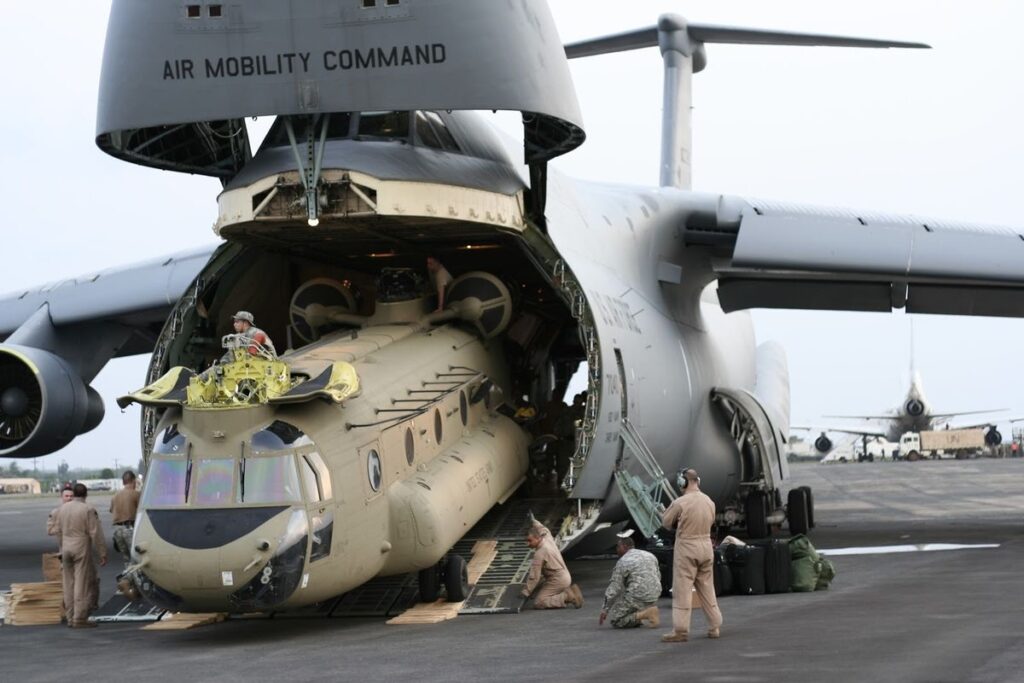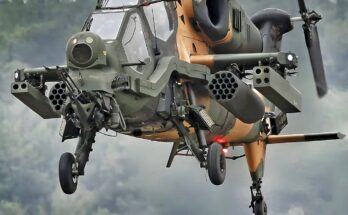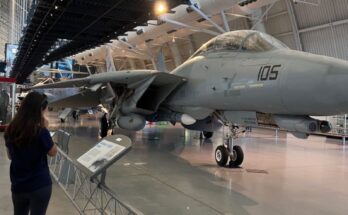
Few moments in military aviation highlight the sheer scale and logistical power of the United States Air Force like the sight of a Lockheed C-5 Galaxy unloading a Boeing CH-47 Chinook helicopter. This scene captures not only the size of these machines but also the complex coordination required to project American military strength across the globe. Together, the C-5 and CH-47 represent a unique combination of heavy airlift and versatile battlefield utility.
The Lockheed C-5 Galaxy is one of the largest military transport aircraft ever built. First flown in 1968, it was designed to carry oversized cargo over intercontinental distances without refueling. Measuring 247 feet in length with a wingspan of 222 feet, the C-5 has the ability to transport nearly anything in the U.S. arsenal—from M1 Abrams tanks to entire helicopters. Its cavernous cargo bay, accessible through both nose and tail doors, allows vehicles and aircraft to be loaded in a “drive-through” fashion, maximizing efficiency during critical missions.
The Boeing CH-47 Chinook, in contrast, is a heavy-lift tandem-rotor helicopter that has served the U.S. Army since the 1960s. Recognizable by its twin rotors and distinctive profile, the Chinook is indispensable for moving troops, artillery, and supplies in both combat and humanitarian operations. With the ability to carry over 20,000 pounds of cargo internally or externally via sling load, the CH-47 is often the helicopter of choice for missions in rugged terrain where ground transport is impossible.
When a C-5 Galaxy unloads a CH-47 Chinook, the event symbolizes the logistical backbone of modern warfare. The Chinook itself cannot travel long intercontinental distances on its own; its range and speed are limited compared to jet aircraft. The C-5 solves this problem by transporting the helicopter—often partially disassembled—to forward operating bases or allied airfields around the world. Once unloaded, the Chinook can be quickly reassembled and pressed into service, sometimes within hours.
This capability is crucial for rapid deployment. In conflicts from Vietnam to Afghanistan, and during humanitarian crises such as earthquake relief operations, the U.S. military has relied on the combination of strategic airlift and rotary-wing support. For example, a C-5 might land at a theater airbase carrying several Chinooks, which are then used to move supplies into remote mountain valleys or disaster-stricken areas unreachable by conventional aircraft.
The visual contrast is also striking. Watching a massive helicopter roll out of an even larger aircraft underscores the scale of American airlift power. The C-5’s interior can accommodate not just one but multiple helicopters, depending on their size and configuration. The process of unloading requires careful planning, as ground crews maneuver the Chinook out of the Galaxy’s cargo bay, often with its rotor blades detached and fuselage secured to prevent damage during flight.
Ultimately, the pairing of the C-5 Galaxy and the CH-47 Chinook highlights the interconnectedness of U.S. air mobility forces. The Galaxy provides the long-distance reach, while the Chinook delivers tactical flexibility once in theater. Together, they represent the ability of the U.S. military to project power and provide aid anywhere in the world. The moment a Chinook emerges from the cavernous interior of a C-5 is more than just a feat of engineering—it is a demonstration of global reach, rapid response, and the enduring importance of airlift in modern military strategy.


